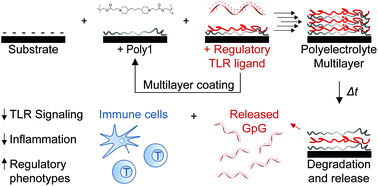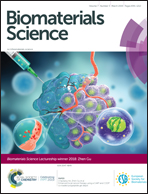Engineering release kinetics with polyelectrolyte multilayers to modulate TLR signaling and promote immune tolerance†
Abstract
Autoimmune disorders, such as multiple sclerosis and type 1 diabetes, occur when immune cells fail to recognize “self” molecules. Recently, studies have revealed aberrant inflammatory signaling through pathogen sensing pathways, such as toll-like receptors (TLRs), during autoimmune disease. Therapeutic inhibition of these pathways might attenuate disease development, skewing disease-causing inflammatory cells towards cell types that promote tolerance. Delivering antagonistic ligands to a TLR upstream of an inflammatory signaling cascade, TLR9, has demonstrated exciting potential in a mouse model of MS; however, strategies that enable sustained delivery could reduce the need for repeated administration or enhance therapeutic efficacy. We hypothesized that GpG – an oligonucleotide TLR9 antagonist – which is inherently anionic, could be self-assembled into polyelectrolyte multilayers (PEMs) with a cationic, degradable poly(β-amino ester) (Poly1). We hypothesized that degradable Poly1/GpG PEMs could promote sustained release of GpG and modulate inflammatory immune cell functions. Here we demonstrate layer-by-layer assembly of degradable PEMs, as well as subsequent degradation and release of GpG. Following assembly and release, GpG maintains the ability to reduce dendritic cell activation and inflammatory cytokine secretion, restrain TLR9 signaling, and polarize myelin specific T cells towards regulatory phenotypes and functions in primarily immune cells. These results indicate that degradable PEMs may be able to promote tolerogenic immune function in the context of autoimmunity.

- This article is part of the themed collection: Biomaterial Interactions with the Immune System


 Please wait while we load your content...
Please wait while we load your content...
